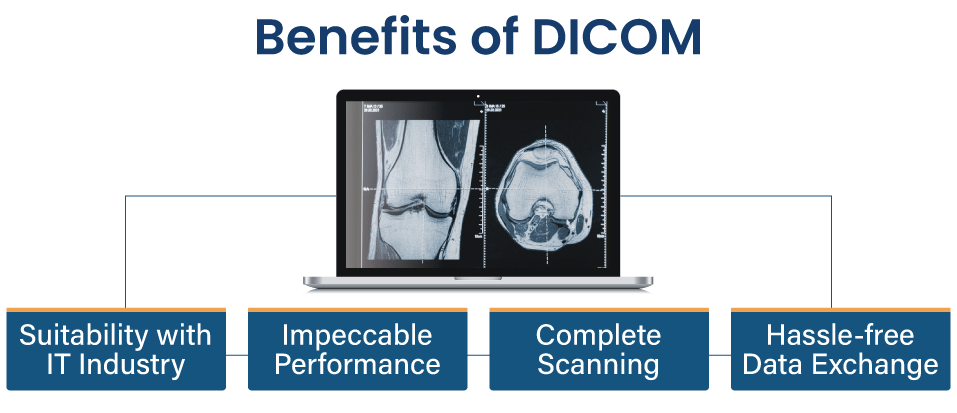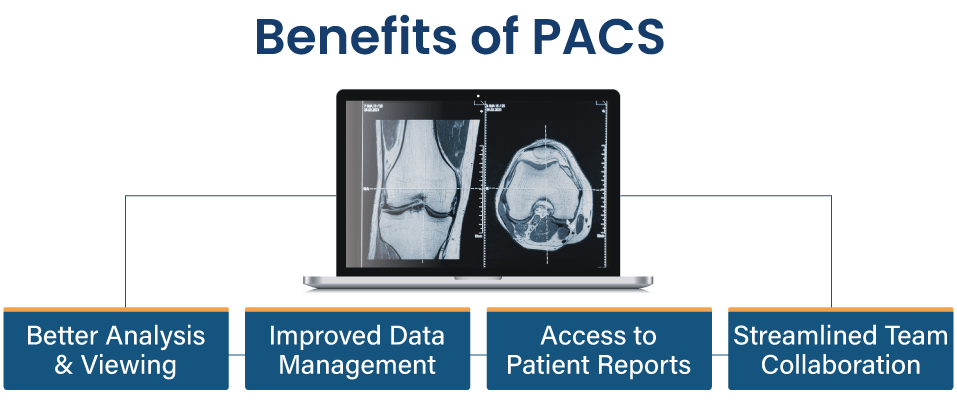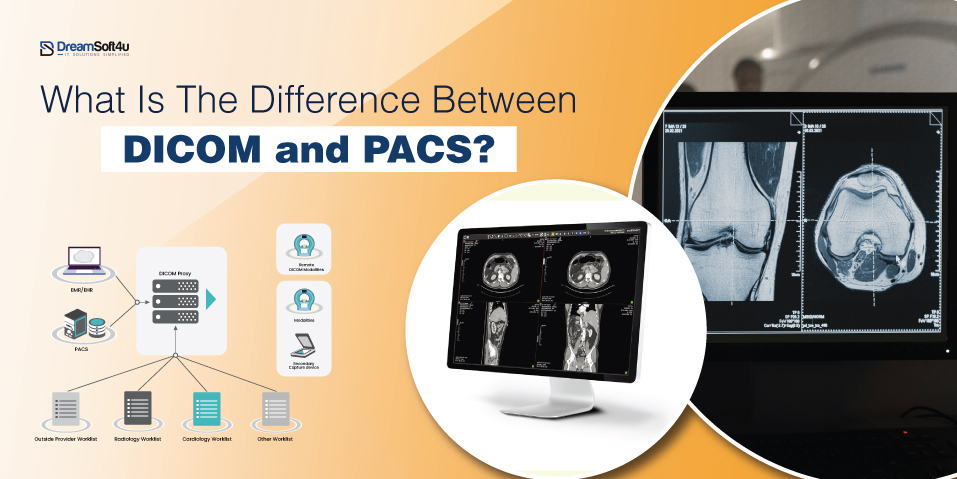Healthcare experts utilize a sequence of jargon to convey themselves, without any surprise in it. People from different industries communicate with each other. This instance is better acknowledged by the folks working in radiology. They require some terms that should be specific to their working hemisphere. DICOM and PACS are such terminologies. So, what is the difference between DICOM and PACS? The post here conveys all these questions in-depth.
In the present day, the utilization of scientific techniques like X-ray, CT (computer tomography) Scanners, MRI, etc. collects enormous amounts of data. Humans are not that capable of understanding the terminology, thus, DICOM and PACS come into play. These decode the entire information for human understanding. Now, How? This would be understood better with the below context.
Table of Contents
ToggleWhat Is DICOM?
DICOM stands for Digital Imaging and Communications in Medicine. It’s the most preferred global standard for exchanging medical data and uses file formats like DCM and DCM30 (DCM3.0). This standard was established by NEMA and ACR. You can find more information about it in our article ‘What is DICOM in Healthcare.’
What is PACS?
Picture Archiving and Communication System is abbreviated as PACS. It is assigned to establish an easier path for handling medical images when it is needed to examine the status of the documents. Simultaneously, the PACS helps in storing the 2D and 3D images.
It is made up of four crucial elements described in the pointers. It acts as the integrating element of all services in the healthcare industry. It performs functions like capturing, storing, viewing, and sharing medical images to external and internal sources.
Four Crucial Elements Are As Follows:
- Medical imaging equipment: MRI, CT, X-ray, Ultrasound, and others.
- A highly secured network for the exchange & delivery of PHI.
- Either DICOM workstations or Cell phones for viewing, re-processing, and interpreting images.
- Moreover, it archives and printers for storing and retrieval of images, related docs, and health reports.
Difference Between DICOM and PACS?
Medical imaging is the best thing to happen for the healthcare industry. It has played a vital role in improving the speed and accuracy of diagnosis and treatment of various medical conditions. In medical imaging, the phrases DICOM Viewer and PACS are frequently used, but what do they mean?
While managing and storing medical images is crucial for both DICOM and PACS, their functions are distinct. Let’s examine the main distinctions between DICOM and PACS and explain why both are essential elements of contemporary healthcare.
Benefits of DICOM
DICOM is a standard international protocol for medical data exchanges. It enables the presentation of data in a particular file format that people can understand. Many benefits separate DICOM from PACS. The most important part is it can convert the CT, MRI, X-ray, and Ultrasound data into readable ones. Other promising advantages that differentiate DICOM Viewers from Pacs are:

1. Suitability with the IT Industry
DICOM is best merged with the Information Technology (IT) sector. In 2010, digital pathology was deployed in the DCIM standards. This integration was accepted by all the healthcare providers. It allowed them to use digital pathology in their prevailing IT sector, moreover, without spending an extra penny.
2. Impeccable Performance
The extensions wherein the images are kept offer high performance whenever these are being utilized. The image with a higher resolution offers the highest data. Here supplement 145 works and recommends a consideration to keep the images in pathology and then maps sub-regions from the layers into the DICOM series.
3. Complete Scanning
Most scanners cannot capture the whole slide of the images, and these are specifically maintained under DICOM standards. It allows the scanners to avoid the uncaptured area and make small-size images.
4. Hassle-free Data Exchange
Interoperability is of great value for patients being transferred between hospitals or medical facilities. DICOM allows for the seamless sharing of medical data and reduces the risk of errors or delays in treatment. Thanks to DICOM, there is a hassle-free and secure exchange of medical image data between different healthcare information systems.
Read Also: Future Trends in DICOM and Medical Imaging Software Development
Benefits of PACS
PACS is a picture archiving and communication system. It helps to safely store, manage, and analyze medical images and reports improving disease diagnosis and treatment.
Professional radiologist utilizes PACS to save all their medical diagnostic files. The data is also shared with the respective medical team. It is accessible at any point in time, people can search through the information and retrieve the images as well.
Experts say that PACS’s major benefit is storing and managing images. These are then utilized to get the status of the documents, patient health, etc. Simultaneously, the data can be accessed anywhere, any place. Here’s a look at some of the key benefits of PACS:

1. Better Analysis & Viewing
The technology facilitates the radiologist to view the digital images by zooming in and getting a closer aspect of the health conditions. It also ensures that the radiologist can manipulate the image. It then helps in better viewing and analysis which ultimately helps in a better diagnosis of the problem.
2. Improved Data Management
One more addon while using PACS is it facilitates magnificent data management efficiency. It reduces an imperative count of duplicate images, it keeps a record of all the previous data electronically.
3. Access to Patient Reports
The best part of PACS is it provides quick access to patient images and reports. It enables tests to be conducted flawlessly and anywhere. Simultaneously, the outcomes can be shared electronically anywhere.
4. Streamlined Team Collaboration
PACS makes it easier for radiologists, doctors, and other healthcare professionals to collaborate more effectively. Patient data and medical pictures can be shared back and forth seamlessly. Care communication and coordination is more timely and accurate. As a result, there is a significant improvement in patient care and outcomes.
Planning for DICOM and PACS Development and Implementation?
We’ve a team of experts who can help you in DICOM and PACS server implementation.
Final Words
Undoubtedly, X-rays, CT Scanners, and MRIs have improved health care. These technologies collect enormous amounts of data. To be truly transformational, these data have to be stored and analyzed securely- which is where DICOM and PACS come into play.
Both DICOM and PACS play a critical role in handling and preserving medical pictures, although their roles are different, and both are key components of modern healthcare. Overall, DICOM and PACS provide invaluable contributions to the healthcare industry and have revolutionized how medical data is stored, shared, and analyzed.
FAQs
Q1. What is the difference between PACS and DICOM?
DICOM is a standard protocol for exchanging medical images, while PACS is a system for storing, retrieving, and distributing medical images. In other words, DICOM is a language that allows PACS to communicate with imaging devices and other healthcare systems.
Q2. How does DICOM integrate with PACS?
DICOM allows PACS to receive, store, retrieve, and distribute medical images and associated patient information from imaging devices and other healthcare systems that also use DICOM.
Q3. What are DICOM systems?
DICOM systems are computer-based systems that support the DICOM protocol for exchanging medical images and associated patient information. These systems are commonly used in healthcare settings.
Q4. Can PACS work without DICOM?
PACS relies on the DICOM protocol to communicate with imaging devices and other healthcare systems, so it cannot work without DICOM.
Q5. Are DICOM and PACS used only in radiology?
DICOM and PACS are commonly associated with radiology. However, they can be used in other areas of healthcare that rely on medical imaging for diagnosis and treatment.






















